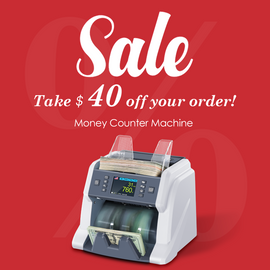Have you ever encountered some unfamiliar specialized terms when purchasing a money counter? For instance, ValuCount, UV/MG/IR counterfeit detection, accumulation mode, and more. These terms may seem strange and confusing for first-time buyers of money counters. To help you better understand these specialized terms, we have prepared a comprehensive glossary of money counter terms, which includes various specialized terms and definitions related to money counting machines. Whether you are using a money counter at work or purchasing a bill counter to handle cash, this glossary will make it easier for you to handle cash with confidence.
- Denomination: The face value of a bill, such as $1, $5, $10, $20, etc.
- Half Notes: Bills that have been torn in half or are missing a significant portion of the note.
- Chain Notes: Two or more bills that are stuck together.
- Double Notes: Two bills that are stuck together and counted as one.
- Serial Number Recognition: A feature that reads and records serial numbers of bills for tracking purposes.
- Piece Counting: A mode that counts the total number of bills, regardless of their denomination or value.
- Accumulation: A mode that allows users to count a certain number of bills and then continue counting additional batches without resetting the machine.
- Bill Loading Style: The method used to load bills into the machine, such as front or back loading.
- Friction Nudge Rubber Roller: A high-quality rubber roller that helps to ensure smooth counting of bills.
- TFT Screen: A high-resolution screen that displays the count and other information.
- ValuCount: A feature that calculates the total monetary value of bills counted based on the selected single denomination.
- UV/MG/IR Counterfeit Detection: A feature that uses ultraviolet, magnetic, and infrared sensors to verify the authenticity of bills and detect any counterfeit bills. Read our detailed guide on security measures in money counter machines here.
- Add and Batch Modes: Operating modes that allow users to add multiple counts together or batch a certain number of bills for easier handling.
- Hopper and Stacker: The parts of the money counter where bills are loaded and stacked after being counted.
- CIS/UV/IR/MG/MT Counterfeit Detection: A feature that uses a combination of contact image sensors, ultraviolet, infrared, magnetic, and metal thread detection to authenticate bills and detect any counterfeit ones.
In conclusion, we hope that The Complete Glossary of Money Counter Terms was helpful in clarifying any specialized terms related to money counting machines that may have been confusing or unfamiliar. However, we understand that there may be additional terms or concepts that you would like to learn more about. If that's the case, please don't hesitate to leave a comment below and let us know what other money counter terms you would like to see included in this glossary.
Furthermore, we believe that using a money counter is a great way to increase efficiency and save time when handling cash. If you are interested in learning more about how using a money counter can help you streamline your cash handling processes and improve your time efficiency, please visit our homepage. Thank you for reading, and we look forward to hearing from you!







